On Tour With My Guitar Heroes: Rick Derringer, Mark Farner and Dave Mason
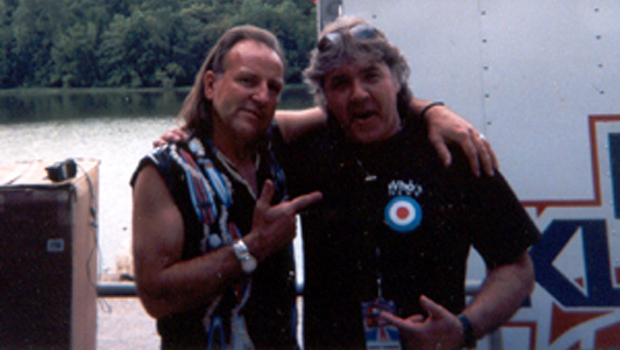
Who’s luckier than me? I’m extremely grateful for having had the opportunity to meet and work with dozens of my favorite musicians over the past 20 years.
This summer, not only am I working with '60s artists such as The Turtles, The Association, The Buckinghams, The Grassroots and Mark Lindsay of Paul Revere & The Raiders on the Happy Together 2011 tour -- but I’m also touring with the Hippiefest 2011 Summer Tour, which features Felix Cavaliere of The Rascals, Gary Wright and guitar heroes Rick Derringer, Mark Farner and Dave Mason.
Above: Happy Together and Hippiefest tour posters.
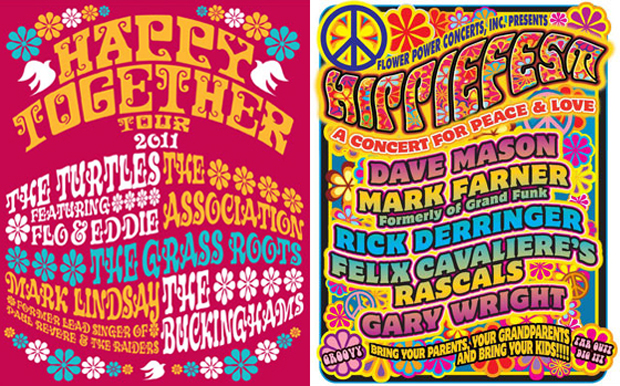
I’ve been the musical director for the Hippiefest for the past five years. The same folks who produced “A Walk Down Abbey Road” summer tours in 2001 and 2002 extended their trust in me to take charge of the musical direction for their Hippiefest and Happy Together tours.
The job of musical director basically means being responsible for determining what instrumentation is needed for each song and then learning the tunes of all the artists we will be backing up and breaking down any vocal harmony parts we would need to sing. It is also necessary to determine if there will be an alternate live version arrangement for any of the songs including beginnings and endings.
Although most artists will send me live CDs or DVDs in advance, I always like to revert back to the original studio versions of the material and hear what was actually played on the recordings. Some of the recorded versions fade out at the end which makes it necessary to come up with a “live” ending.
“A Walk Down Abbey Road,” “Hippiefest” and “Happy Together” are presented in a concert format similar to Ringo Starr’s All-Starr band tours. As a matter of fact, many artists like John Entwistle, Todd Rundgren, Jack Bruce, Mark Farner, Felix Cavaliere, Rick Derringer and Gary Wright have at one time or another been members of Ringo’s tours. (Rick Derringer and Gary Wright just jumped off Ringo’s tour this summer to join us on Hippiefest.)
Get The Pick Newsletter
All the latest guitar news, interviews, lessons, reviews, deals and more, direct to your inbox!
So to get down to the actual topic of this week’s blog, I’d like to start by saying that I have actually been a fan of all 3 of these guitarists since I was a teenager.
Mark Farner
Above: Mark and I on tour in 2002.

Mark was originally the lead vocalist and lead guitarist for Grand Funk Railroad, one of the very first power trios of rock music (1969-1976). I was totally into their first few albums, On Time, Grand Funk (The Red Album, Closer To Home and the double Grand Funk Live Album, which all came out in 1969-1970.
- By 1971, Grand Funk broke The Beatles' Shea Stadium attendance record by selling out in just 72 hours.
- One of the most notable Grand Funk tunes for someone who played guitar back then was, “Inside Lookin’ Out”…particularly, the “live” version which featured an extended guitar solo. Every band in the neighborhood attempted to play this song at the local teen dances and if you could play the solo to “Inside Lookin’ Out,” you’d be considered “the bee’s knees” (as they used to say … somewhere).
Probably my favorite GFR song is “Sin’s A Good Man’s Brother” from the Closer To Home album. It’s got a nasty riff that runs throughout it and Mark’s vocals are killer as well. You can imagine my delight when he told me he wanted to do it in the set during one of our pre-production phone conversations a few months ago. I had already been thinking like a musical director and was planning on suggesting it to him as a good choice for replacing one of his other “lighter” hit single type tunes like “Some Kind Of Wonderful” and “Locomotion.” (Especially for a concert boasting the title “Hippiefest.”)
Above: Grand Funk Railroad album covers.

Drummer Steve Murphy and I first worked with Mark during the “A Walk Down Abbey Road” Summer 2002 tour. On this tour, each headline artist (of which there were five) would play a few of their own hits as well as being featured on a few Beatles covers.
We played “Bad Time,” which was a top 10 hit for Grand Funk in 1975, and “Closer To Home,” which could easily be considered one of the most significant rock anthems of the '70s. Mark also covered The Beatles’ “Things We Said Today” during our acoustic portion of the show, and his own “nasty riff” rendition of George Harrison’s “Taxman.”
The tour played about 30 dates and lasted the entire summer of 2002. Mark traveled on the tour bus with the band and we got to know each other pretty well and had a blast hanging out on and off stage. Over the past nine years we’ve kept in touch and also done a one-off Hippiefest gig as well as crossing paths in an airport on our way to different gigs.
From left: Jack Bruce, Mark Farner, Godfrey Townsend and Christopher Cross.
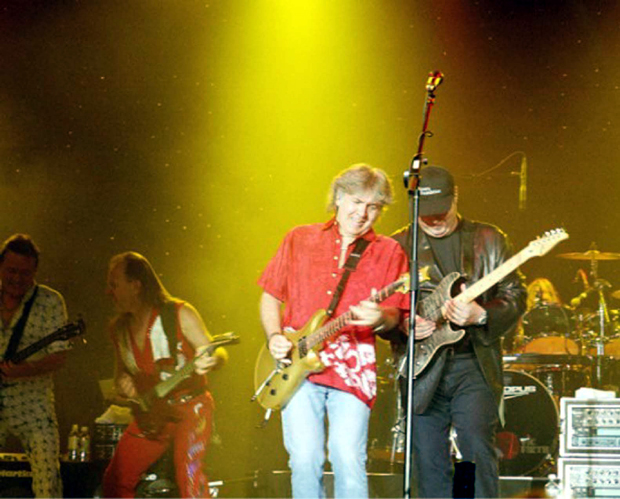
Mark is such a warm, friendly down-to-earth person that hooking up with him again on this summer’s Hippiefest feels like re-connecting with an old friend. If I’m not mistaken, his voice is even better, his playing is great and his performances have been powerhouse and show-stopping every night. Non-stop energy from the opening of “Foot-Stomping Music” to the end of his closing number, “Closer To Home.”
He’s using a Parker Fly guitar and playing through two Fender Twins.
Rick Derringer
Above: Rick and I on the tour bus, Hippiefest 2011.
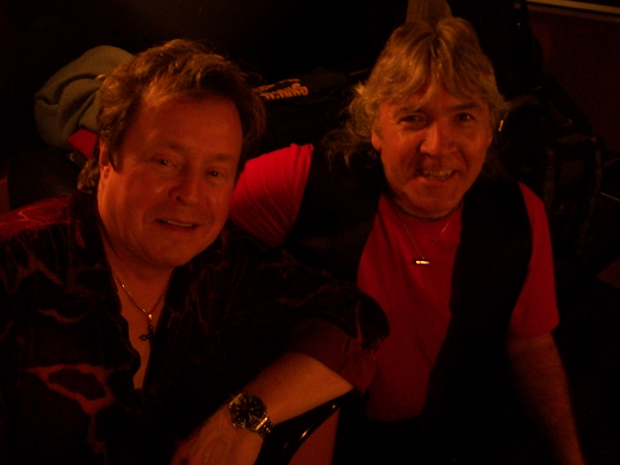
I first became aware of Rick when I heard the Live Johnny Winter And album. Rick originally had a band called The McCoys which had a huge #1 hit with the song “Hang On Sloopy” in 1965.
In 1970, The McCoys joined up with Johnny Winter. They were originally going to be called, Johnny Winter And The McCoys but shortened it to Johnny Winter And.
I just happened to get turned on to their live album before hearing their debut studio album. One of the more notable tunes from the live album was a rendition of The Rolling Stones’ “Jumpin’ Jack Flash.” Another fave was a blistering rendition of “Johnny B. Goode.” Both of these songs would quickly become “staples” for local bands to play on the teen dance circuit around my neighborhood in 1971.
Even though Rick was actually the second guitarist, he did play some great stuff behind Johnny and I paid close attention to his playing style. Not only did he write several of Johnny’s biggest songs (“Rock And Roll Hootchie Koo,” “Still Alive And Well” and “Cheap Tequila”) but he also produced Winter’s big comeback album of 1973, Still Alive And Well, and the follow-up, Saints And Sinners, in 1974.
Around the same time, Rick released his first “solo” album, All American Boy, and had his own top 40 chart hit with “Rock And Roll Hootchie Koo.” As if that’s not enough for one person to do, he also played with Johnny Winter’s brother’s band, Edgar Winter’s White Trash. He was Edgar’s guitarist for a studio album (1971) and an incredible double live album, Roadwork (1972). PLEASE find a copy of the live album, and especially listen to the AMAZING guitar solo Rick plays on “Tobacco Road.” It starts out with Rick mimicking some licks that Edgar is scat singing and then it just takes off into a blistering solo of the most out of this world scales and arpeggios ever heard.
The most significant influence that Rick’s music had on me came in 1976 when Rick formed the band “Derringer” with guitarist Danny Johnson, bassist Kenny Aaronson and drummer Vinnie Appice. I had a four piece band at the time, with dual guitars, bass and drums and we practically learned their entire debut album, (Derringer) as well as a few tunes off their follow-up album Sweet Evil (1977).
Derringer also released a live album in 1977 which we also assimilated for live versions and extended dual guitar solos. The other guitarist in my band played a lot faster than me so he took the more chromatic scale style Derringer licks and I played the Danny Johnson licks which were a bit slower and more blues influenced. I also recommend checking out these three albums for a wealth of great rock-blues guitar playing.
At some point in 1994, I was playing in a band with Sony Recording Artist, Martin Briley (“Salt In My Tears”). We were gigging at New York City’s Le Bar Bat club when Rick and his band walked in. During a break, I went over to their table to say hi and Rick asked if he could get up and jam. I quickly arranged it and Rick and his drummer Tom Curiale got up to play a few tunes with us. Rick was playing a Fender Stratocaster at the time (See photo below). I definitely remember jamming on Stevie Ray Vaughan’s “Pride And Joy” and I’m sure we also played “Hootchie Koo.”
Above: Rick and I jamming in 1994.
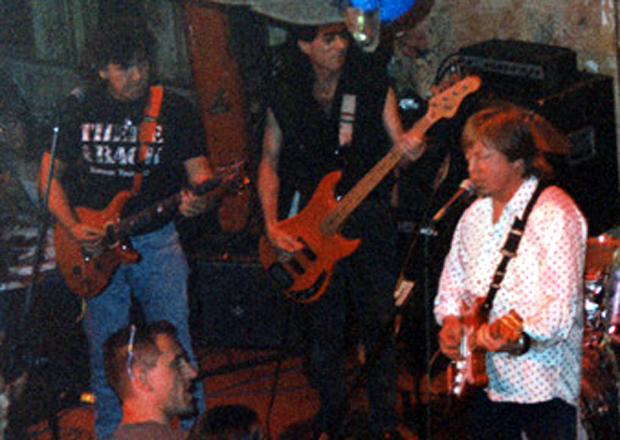
Playing behind Rick on this tour is like a dream come true for me. So much of what he’s done has influenced my playing style and inspired my enthusiasm to persevere in what is a real tough business to be in.Rick’s a great guy…I enjoy engaging him in guitar talk. Last night, we were sitting on the tour bus and I started him talking about the peculiar candy apple red strat he’s pictured with on the cover and in the gatefold of the All American Boy album. I got the idea to put telecaster knobs on my strat after seeing him do it on there. But, the real oddity about that guitar is that it has a Gibson style stop tailpiece instead of a Fender style tremolo unit. Check it out on my website on my Fender Stratocaster page.There is also an amazingly historic story about a certain '50s Gibson Les Paul that Rick owned in the '60s. In a nutshell, it was originally a goldtop that previously belonged to John Sebastian of the Lovin’ Spoonful. Rick had it refinished in SG Cherry Red at Gibson’s Kalamazoo factory and didn’t much like it afterwards. He traded it at Dan Armstrong’s NY store for a Sunburst Paul. Eric Clapton walked in and bought it. He later used it for his legendary solo on The Beatles' “While My Guitar Gently Weeps.” He later gifted the guitar to Harrison, who used it on The Beatles (The White Album) and Let It Be. It was later stolen from under Harrison’s bed in Beverly Hills, bought and sold by Guitar Center to someone in Mexico, from whom Harrison bought it back.See the entire story here.NEXT WEEK: GUITAR HERO 3 / ON TOUR WITH DAVE MASONDon’t forget to check out my website for more info and check out CD Baby to buy my CD.
“This particular way of concluding Bohemian Rhapsody will be hard to beat!” Brian May with Benson Boone, Green Day with the Go-Gos, and Lady Gaga rocking a Suhr – Coachella’s first weekend delivered the guitar goods
“A virtuoso beyond virtuosos”: Matteo Mancuso has become one of the hottest guitar talents on the planet – now he’s finally announced his first headline US tour










